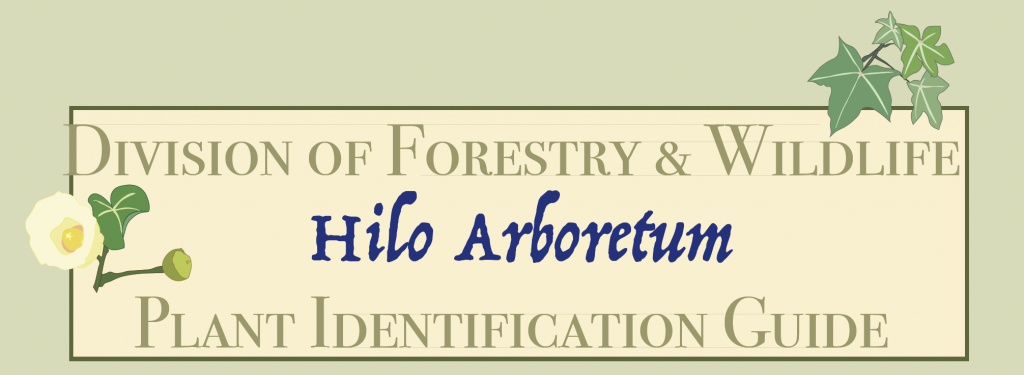Hilo Arboretum Plant Guide
 The Hilo Arboretum is community space located between E Kawili Street and Lanaikāula Street in Hilo. The area is used for planting and can be a great place for residents and visitors to explore and learn about plants. The Hawaiʻi Island Branch of the Division of Forestry & Wildlife provides the following resources to help guide your exploration:
The Hilo Arboretum is community space located between E Kawili Street and Lanaikāula Street in Hilo. The area is used for planting and can be a great place for residents and visitors to explore and learn about plants. The Hawaiʻi Island Branch of the Division of Forestry & Wildlife provides the following resources to help guide your exploration:
- Hilo Arboretum Maps and Quick Look Plant Guide
- Plant Family Factsheets:
Use the map application below to identify trees or find a tree you’re looking for.
History of the Hilo Arboretum
In 1909, Brother Matthias Newell was appointed to the Territorial Board of Agriculture and Forestry in order to establish a tree nursery on Waianuenue Avenue in Hilo. He raised plants and maintained the early plot, and in 1910, distributed 3,500 trees throughout the community on Hawai‘i Island. Overtime the number of plants grown increased as supplies, equipment, and support were provided by the Territory. Meanwhile, in 1913, a four acre animal quarantine station was established on Kilauea Avenue, and by 1919, a building was added. Dr. Harold B. Elliott was in charge of operations at the station and interested in horticulture, so he began planting eucalyptus and silk oaks along the boundary of the quarantine station.
In June 1920, the tree nursery on Waianuenue Ave. was moved to the animal quarantine station, enlarging its grounds with the addition of old cane land. The Hilo nursery was meant to provide trees for plantations and private home owners because import from outer islands was illegal at the time. Plants were raised from seed and sugarcane was removed to make room for a variety of tree species. By August 1920, a substation for the Board of Agriculture and Forestry was built and nursery grounds continued expanding. As the site of the animal quarantine station discontinued use, Dr. Elliott began working alongside Brother Matthias and Tony Aguiar, who became resident superintendent. The three began planting flowers alongside seedling trees, including numerous varieties of canna lilies. Their collection of cannas was exceptional and the rhizomes were sold to residents.
In 1923, Charles S. Judd, Director of the Territorial Board of Commissioners of Agriculture and Forestry, and L.W. Bryan, Forestry Superintendent, further expanded the nursery with the purchase of additional cane land. Land clearing began and loose rocks were uncovered, becoming the source material for the rock wall along Kilauea Avenue of the present-day Arboretum. A house was also built during this time, which stands today as the Manager’s quarters. These projects took several years and nursery work was maintained for the duration.
The Board of Agriculture and Forestry became active in the introduction of plant species from around the world, and by 1935, the Hilo nursery was 30 acres large, containing 700 different species. Ornamental, fruit, and timber trees were grown at the Hilo nursery, and in 1936, one million trees were planted from nursery stock by the Civil Conservation Corps and private landowners. Labor saving innovations, like a narrow gague railroad, and broad community support compelled the nursery’s growth. Almost twenty years later, in 1952, 10 million trees were distributed from the nursery across Hawai‘i Island, landscaping parks and roadsides.
As private nurseries were established 10 acres of the nursery land was returned to the Territory for homesites, making the total acreage 19.45 as it stands today. Then in 1964, legislative action was taken to establish the State Tree Nursery in Waimea, and the district phased out its nursery operations in Hilo. The Hilo Arboretum is now used as a internal planting project and community space while the Waimea State Tree Nursery grows timber trees, native trees for reforestation, and some rare and endangered plant species.
